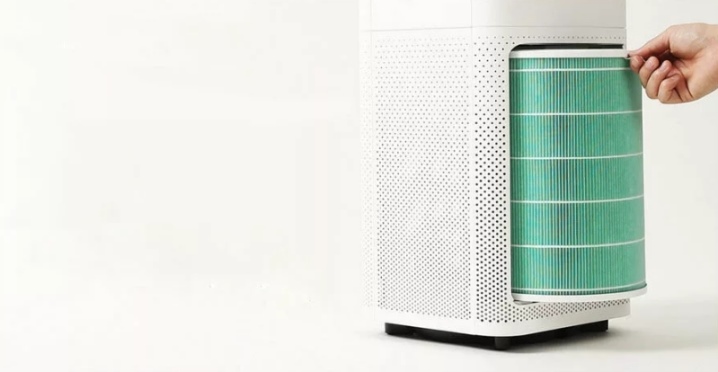Air purifier filters: how to choose and replace?

Air purification and humidification are very important processes for human life. These actions, which are performed with one simple device, reduce the chance of contracting lung diseases by up to 1%, and also kill all fungi. In addition, air purification and humidification make life much easier for people who are allergic to dust or pollen.
In order for the air purifier to work efficiently, it is necessary to periodically replace special filters in it.


Existing types of filters
A fairly large number of filters can be found on sale. In order not to get confused in them when choosing for your device, you need to know about all types, their advantages and purpose.

Electrostatic
2 metal plates are used as a filter. Between them, the device creates an electrostatic field, which attracts dust to itself. Thus, by passing air through the device, it is possible to remove up to 90% of the dust from it, which is a good result. However, if the air in the apartment is very dirty, the purifier may not be able to cope. In such cases, a more advanced filter with a different cleaning principle is needed.


Mechanical
For more effective air purification, devices with mechanical HEPA filters can be used. These filters are an accordion made of fibrous material. A device that uses these filters draws in air with a fan. Thanks to this, the air is almost completely rid of fungi, dust and plant pollen.
Devices with such a filter will work well even at high humidity, which is also an undoubted advantage of this type.


Coal
Such filters are used for fine cleaning of indoor air. Devices with these filters are able to rid the environment of various harmful impurities and even gases. It is worth noting that they are unable to qualitatively clean the air from ordinary dirt and bacteria, so it is recommended to install an additional filter for this task. Unlike the previous type, devices with carbon filter elements will not perform well in high humidity conditions. Due to this very moisture, the coal will get wet and lose its cleaning ability.


Photocatalytic
Some of the best and most efficient air purifier filters on the market are photocatalytic. The principle of their operation is as follows: an ultraviolet lamp and a catalyst are installed inside, which together give a very deep cleaning effect. Thanks to just such a device, the filter can rid the air in the room from many harmful factors: bacteria, dust, viruses, dust mites, mold, toxic organic matter, phenol fumes (released from furniture), toxins, impurities, soot, carbon monoxide, tobacco smoke and more.
Despite the huge number of advantages, these filter elements also have one drawback. It consists in the fact that such cleaners destroy not only all harmful bacteria, but also neutral ones (this affects the immunity of children, so the devices cannot be turned on in children's rooms for a long time).

Aquatic
.One of the simplest and most ineffective types of filters, working on the "washing" principle. Devices with them are able to clean the air in the apartment only from dust and pollen. However, due to the simplest principle of operation (air is simply sucked into the device and passes through the water layer), the purifier can save you 95% of all dust in the room. This is an excellent indicator for a filter whose purpose is only to remove the smallest particles of dirt.

Thermodynamic
One of the newest filter elements for air purifiers. The principle of operation is based on heating the air to a temperature of about 200 degrees. These filters are very effective, because they destroy up to 100% of bacteria, viruses and debris that saturates the air in the house. Fire at this temperature does not occur in the device, so it is absolutely safe.
The device emits a small amount of carbon dioxide, mineral salts and water vapor as waste from "combustion" (all this is completely safe for human life and health).


Manufacturing companies, their pros and cons
On sale you can find filters from various well-known brands. To choose a filter specifically for your device, you should know not only about the types, but also about the nuances of products from different manufacturers. Before buying, do not forget to make sure that your device accepts exactly the filter element that you have chosen (these filters may differ from purifiers from different companies).
Philips
In general, the filter elements from this company are of a fairly high quality. Most buyers choose them precisely because of the good assembly and the quality of the materials themselves used in the manufacture. Philips filters do not have an unpleasant odor, which is also a definite plus. The disadvantages include their price and the fact that they are not universal. For the most part, Philips filter elements are only suitable for branded devices.

Scarlett
Another manufacturer with a quality product. The assembly of filters and their components will delight even the most fastidious customer. There are universal filter elements on sale, which is also good news. The products are not the most expensive on the market, but not the cheapest (the price range is quite suitable for a buyer with an average income).
The disadvantages include the fact that defective devices are often found, as well as the fact that filters can emit an unpleasant odor.


Sharp
A Japanese brand that has earned the trust of buyers for a long time. The quality of the products from this company is higher than that of Philips and Scarlett. The brand is constantly introducing new technologies, so quite often you can find something new in their range of filter elements. The average cost of products is on the level of Philips or slightly higher, but the quality is worth it. All products are free from unpleasant odors and are made of high quality environmentally friendly materials.
Sharp filters have no downsides as such. Many buyers attribute to them only the high price of the product, but note that the high quality deserves such a price.


Tefal
One of the most famous brands in the world for the production of dishes and many household products, including filter elements. The price range of the goods is at the Sharp level, but the quality of Tefal is slightly inferior. It should be noted that the quality of Tefal products is still higher than that of Philips, but lower than that of Scarlett.
The disadvantages can be safely attributed to the fact that clean, environmentally friendly materials are not always used in filters. In addition, the very "filling" of the filters goes out of the working state rather quickly, which will force you to change elements more often.


Replacing the filter element
In order for your purifier or air washer to function correctly, you need to periodically replace the filter. This is a fairly simple process if you have done it at least once, but for those who are still new to this business, various difficulties may arise.
Depending on the type of cleaning device, filters should be changed every 3 months or six months.If we are talking about photocatalytic, thermodynamic, mechanical or electrostatic filters, then they should be replaced at least once a year (or better - once every six months). If your device accepts water or carbon filter elements, then it is worth replacing them at least every six months or even more often.
Algorithm for replacing the filter element for most purifiers:
- disconnect the device from electricity and unscrew the back cover;
- take the filter and remove the protective shell from it;
- take out the previous filtering element and install a new one in its place, fixing it in special grooves (or screw it on);
- collect the device and plug it in, then reset the usage counter.

For an overview of Tefal's NanoCaptur filter, see the next video.













The comment was sent successfully.